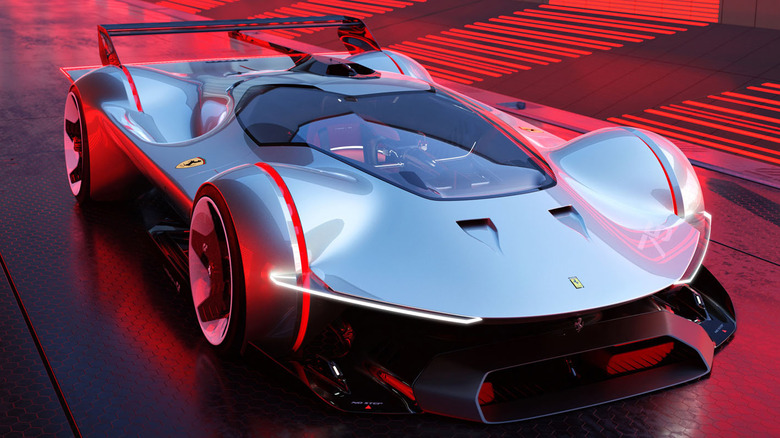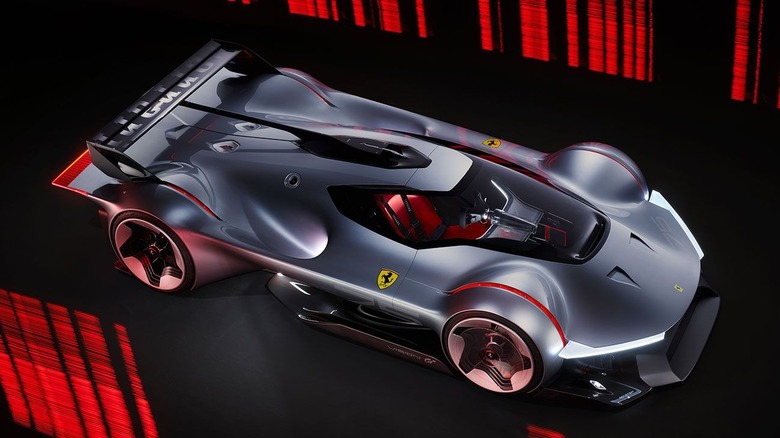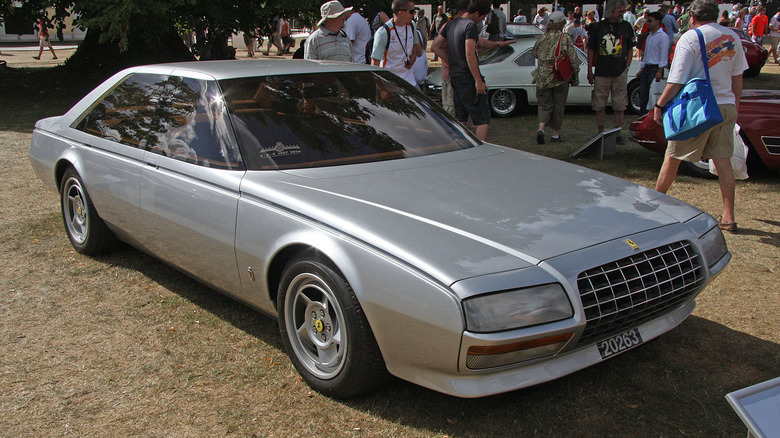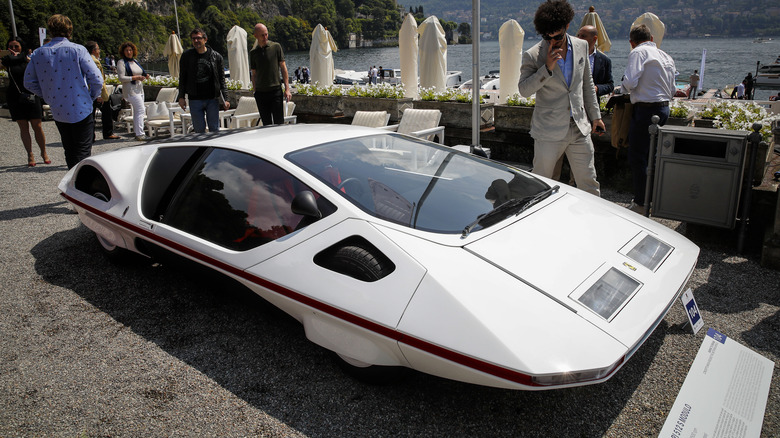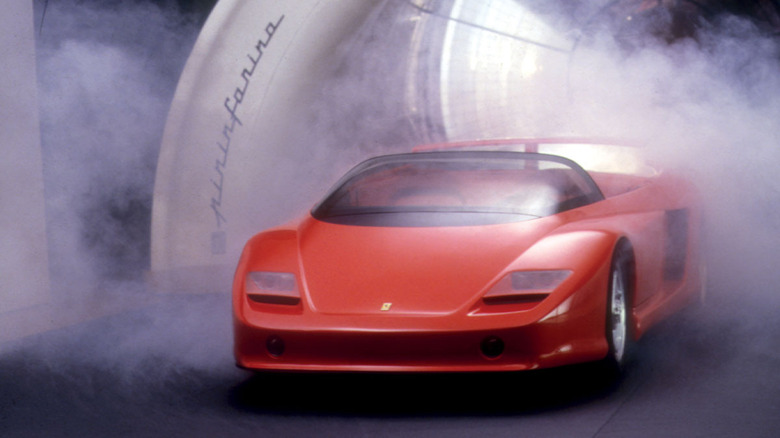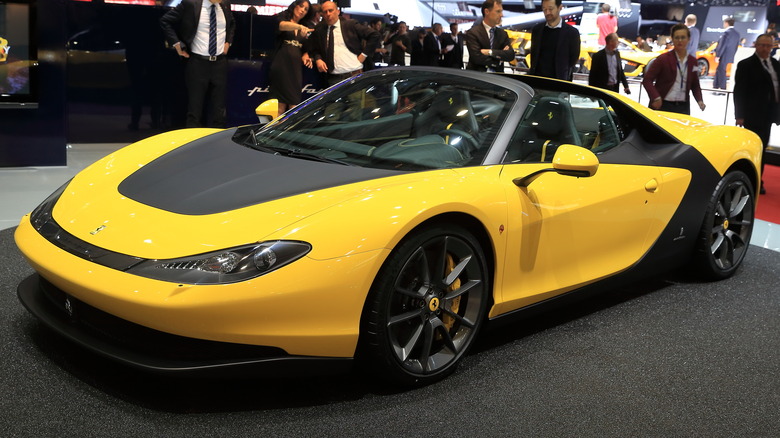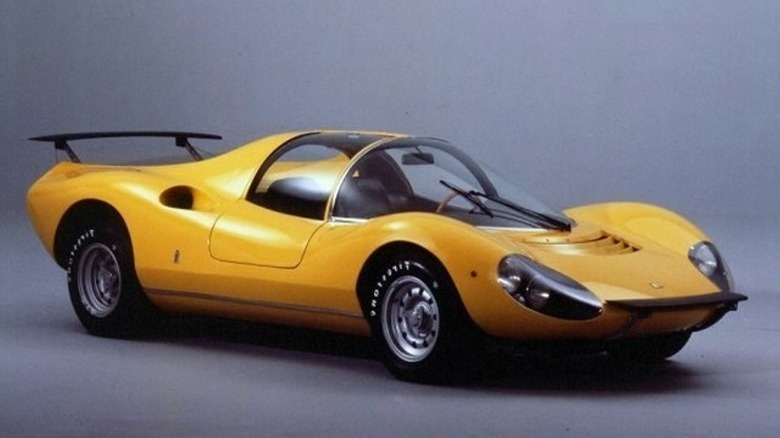10 Coolest Ferrari Concept Cars Ever Made
For a company with such a rich history of low-volume specials, racing prototypes, and cutting-edge hypercars, Ferrari has made relatively few concept cars. The concepts that do make it out of the doors of Maranello are therefore automatically special even by Ferrari standards, with many of them built to commemorate milestones in Italian automotive history. Not every Ferrari concept is built for special occasions, however –- a few also show off cutting-edge technology or design features that eventually make their way into the brand's production cars.
New Ferrari concepts are few and far between, and as a result, some of them have been largely forgotten about over time. Many of those lesser-known concepts are created to showcase future design language, although not all -– one was even designed to be a daily driver for the man behind the original VW Golf.
Whether they're outlandish, pioneering, stunning, or a mix of all three, these ten concepts represent the best from Ferrari's back catalog.
Ferrari 408 4RM
Although the FF was the first production four-wheel drive Ferrari, it wasn't the first time the Prancing Horse had experimented with sending power to all four wheels. That honor instead goes to the 408 4RM, first built in 1987, of which two examples were constructed. With a 4.0L V8, a classic wedge design, and an immaculately finished interior, you could be forgiven for mistaking it for a production car at first glance. However, the car was only ever intended to be a technological concept, showcasing Ferrari designer Mauro Forghieri's cutting-edge four-wheel drive system.
The idea of a four-wheel drive sports car was alien to the auto industry at the time, with only SUVs and a few rally cars sporting such systems. Ultimately, it was decided by Ferrari executives that the 408 4RM had no production potential, no doubt partly thanks to the slightly awkward proportions of the concept. It took another quarter of a century for the FF to come along, but its pioneering predecessor can still be seen at the Galleria Ferrari in Maranello.
Ferrari Vision Gran Turismo
Ferrari joined the ranks of manufacturers to have created concepts specifically for the "Gran Turismo" franchise in 2022 when it unveiled the Vision Gran Turismo. According to Ferrari, Kazunori Yamauchi, the creator of the legendary video game series, personally reached out to ask the brand if it would design a "rendition of the ideal GT."
The Vision Gran Turismo was the result –- a futuristic, streamlined racer with a hybrid gas-electric powertrain making 1,338 horsepower. Ferrari took design inspiration from its classic '60s and '70s racing prototypes, combining past and present to create a design language that the brand says will influence its future road and race cars.
Although the car was designed strictly for the virtual racetrack, a full-size design study was also produced and showcased at the Ferrari Museum in Maranello between December 2022 and March 2023. It launched in "Gran Turismo 7" at the same time, making this one of the only Ferrari concepts that can be experienced by almost any fan of the brand — albeit virtually.
Ferrari Pinin
Ferrari's first production four-door car is the Purosangue SUV, a car that, just a few years ago, seemed unthinkable that Maranello would ever make. Car reported that the company's CEO announced at the 2016 Geneva International Motor Show that SUVs were "not in our DNA" — yet just two years later, the first plans for the Purosangue were unveiled. Similarly radical plans were once considered for the first four-door Ferrari concept, the Pinin, which debuted in 1980 to a shocked crowd at the Turin motor show. Designed by Pininfarina as a way to commemorate its 50th anniversary, the Pinin was a luxurious limousine powered by a flat-12 engine, a world away from anything Ferrari had made before.
It drew enough attention that Ferrari bosses considered making a production version, but those plans never came to fruition. The Italian automaker had no prior experience making luxury vehicles, and it was deemed too expensive and time-consuming to develop such a car. Only one non-functional concept car was ever produced, and it was eventually bought by a private collector.
In an interesting epilogue, 30 years after it was originally unveiled, the Pinin was rebuilt as a functional vehicle with the help of legendary Ferrari designer Mauro Forghieri. It remains in a private collection and stands as a testament to the time that Ferrari nearly made a car no one thought it ever would.
[Featured image by Brian Snelson via Wikimedia Commons | Cropped and scaled | CC BY-SA 2.0]
Ferrari Modulo
One of the most outlandish concept cars of its era, the Ferrari Modulo was the product of a plucky young designer at Pininfarina named Paulo Martin. The basic silhouette was actually penned before Ferrari gave Pininfarina a 512S chassis to work on, but it ended up fitting perfectly. The donor 512S was no longer functional, as Ferrari only wanted a show car, but the original 5.0L racing V12 stayed in place so it could be viewed through the rear of the car. The concept debuted at the Turin Auto Show in 1970, across the hall from the equally wedgy Lancia Stratos Zero and Porsche Tapiro.
The cutting-edge designs of the trio went on to influence the supercar industry for the next couple of decades, although no production supercar managed to cut quite as unique a shape as the Modulo. After touring auto shows for more than a decade, Pininfarina eventually retired the car before selling it to Jim Glickenhaus in 2014.
Glickenhaus is the man behind SCG, an automaker that sells, among many other things, one of the weirdest SUVs on the market. He's also an avid Ferrari collector and eventually rebuilt the Modulo to be fully functional, even registering it with a New York license plate so he can drive it on the road.
Ferrari Rossa
While it's not as well remembered as some of Ferrari's other concepts, the Rossa was instrumental in shaping the designs of the production cars that would follow it. Unveiled in 2000, the Rossa was built to commemorate Pininfarina's 70th anniversary and was based on the platform of the 550 Maranello. It kept the donor car's 5.5L V12 engine, although it featured such a low-slung design that a hole had to be cut in the hood to accommodate it. Performance figures were never officially disclosed, although the concept itself was fully functional.
The car's exterior design debuted a number of stylistic features that would go on to make appearances in the brand's production cars –- the protruding rear tail lights, for example, featured on the Enzo, 612 Scaglietti, and F430. The Rossa also included tech additions like a rear camera for reversing which could be viewed through an LCD screen in the center console, foreshadowing the infotainment screens that would eventually make their way into Ferrari's production lineup.
After its debut at the Turin Motor Show in 2000, the Rossa concept was sent back to Pininfarina. It remains in the studio's official collection today.
Ferrari Mythos
Before the Rossa was unveiled in 2000, the previous Ferrari concept had been the Mythos. Much like the Rossa, its time in the spotlight was brief, especially since the car was sold to a private Japanese collector after it finished its initial auto show tour. Nonetheless, the Mythos' design influence continued to be felt throughout the following years, as the concept's designer Pietro Camardella took inspiration from it while working on his next big project, the F50.
Although only one official Mythos concept was produced, the car caught the attention of the Sultan of Brunei, who used his influence to convince Ferrari to build two more examples for his private collection. Those two cars were never shown publicly, but up until the mid-'00s, visitors to the Gallery Abarth Museum in Japan could see the original concept in the flesh.
After the museum closed, the Mythos has only been seen in public once more — at an event in Monaco in 2019.
Ferrari Sergio Pininfarina
Based on the internals of a Ferrari 458 Spider but with a striking speedster appearance, the Pininfarina Sergio was built to honor the legacy of the company's chairman, who passed away in 2012. Sergio was the son of Battista "Pinin" Farina, the founder of the studio that bore his name. After Battista's death in 1966, Sergio took over and would go on to lead the company for forty years. The Sergio concept takes inspiration from many of the Italian studio's greatest designs from that period, including the '60s and '70s prototype racers that would go on to forge Ferrari's legacy as a dominating force in the racing world.
Although it was Pininfarina who shaped its form, the Sergio concept proudly wears the Prancing Horse logo as a tribute to the long-standing relationship between the two companies. Arguably, neither the design studio nor the automaker could have ever risen to the top without each other -– after all, Ferrari's technical excellence would have not had such an impact on supercar buyers were it not for the consistently stunning silhouettes Pininfarina had packaged them in.
As well as honoring its chairman's legacy, the Sergio turned out to be a milestone in the history of the long-standing partnership, as it was the last concept car produced before Ferrari unofficially parted ways with Pininfarina to focus on designs from its in-house studio, Ferrari Centro Stile.
Ferrari Dino 206 Pininfarina Berlinetta Speciale
Unveiled at the Paris Motor Show in 1965, the Dino Speciale, as it became known, was designed to preview what Ferrari's upcoming Dino production car could look like. It featured striking quad headlights that were mounted much lower than previous Ferraris and covered by Plexiglas. While this particular design feature never made it to the brand's production cars, the air intakes carved into the sides would go on to become a hallmark of Ferrari's cars for decades to come.
Enzo Ferrari was said to be unsure of the car's design since its compact proportions meant that there wasn't enough room for him to drive it comfortably, but he allowed development to continue anyway. After its appearance at several auto shows, the Dino Speciale was sent back to the Pininfarina plant before it was gifted to the Le Mans Museum in 1967.
The production Dino ended up looking quite different from this original concept but went on to be a great success and arguably one of the brand's greatest models of all time.
Ferrari GG50
Unlike many of Ferrari's concept cars, the GG50 was not created by Pininfarina, but rather by Giorgetto Giugiaro of Italdesign. The car's name is derived from his initials and the milestone that the concept was designed to celebrate, namely Giugiaro's fifty years as a car designer. It was intended to be for the designer's personal use, and as such, it incorporates several unusual design features for a Ferrari.
One of those features is a tailgate, which allows for easy access to the rear of the car. The rear seats can, in turn, be folded down to create a cargo-carrying space measuring around 4.5 feet in depth, giving the GG50 a maximum cargo capacity of 500 liters, as opposed to the 240 liters of the 612 Scaglietti that it's based on.
The concept retains all of the internals of the 612 Scaglietti, making it not only fully functional but one of the only Ferrari concepts to have been designed primarily for practicality rather than as a pure design showcase.
Ferrari Dino 206 S Pininfarina Competizione
The Dino 206 S was created so Ferrari could go racing in 1966, but in order to meet homologation requirements, a run of 50 units had to be produced. Thanks to slow sales and strikes from workers, only half of the required cars were actually built, leaving the automaker with some unfinished chassis lying around by 1967. Rather than let them go to waste, Ferrari sent three of them to Pininfarina, where chassis 034 would be turned into the Dino 206 S Pininfarina Competizione concept.
The Competizione borrowed a V6 engine from one of Ferrari's 1966 Le Mans race cars and sported a heavily revised design that was clearly influenced by its racing counterparts. As a show car, there were virtually no practical constraints to limit the creativity of Pininfarina's designers, and the resulting concept combined elements of both road and race car design into one striking vehicle.
The car debuted at the Frankfurt Motor Show in 1967, then made appearances at motor shows in Paris and Los Angeles the same year. It was then returned to Pininfarina's collection before being sold off to noted Ferrari collector James Glickenhaus in 2008.
[Featured image by Paolo Martin via Wikimedia Commons | Cropped and scaled | CC BY-SA 3.0]
